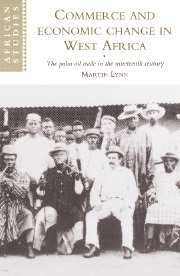Book contents
- Frontmatter
- Contents
- List of maps
- List of tables
- Preface
- List of abbreviations
- Introduction
- Part I The development of the palm oil trade in the first half of the nineteenth century
- 1 The West African trade in transition
- 2 African producers and palm oil production
- 3 African brokers and the growth of the palm oil trade
- 4 British traders, British ports, and the expansion of the palm oil trade
- Part II The restructuring of the palm products trade in the second half of the nineteenth century
- Conclusion
- Notes
- Select bibliography
- Index
- Other books in the series
3 - African brokers and the growth of the palm oil trade
Published online by Cambridge University Press: 04 December 2009
- Frontmatter
- Contents
- List of maps
- List of tables
- Preface
- List of abbreviations
- Introduction
- Part I The development of the palm oil trade in the first half of the nineteenth century
- 1 The West African trade in transition
- 2 African producers and palm oil production
- 3 African brokers and the growth of the palm oil trade
- 4 British traders, British ports, and the expansion of the palm oil trade
- Part II The restructuring of the palm products trade in the second half of the nineteenth century
- Conclusion
- Notes
- Select bibliography
- Index
- Other books in the series
Summary
Continuity characterised the broking networks of the West African trade in the years before 1850. Here the structures and practices that had evolved in the slave trade era continued to determine the trade in palm oil. It was precisely this that allowed the great increase in exports of oil to occur as it did in these years. The figures involved in these trades – the coastal brokers who bought the oil from the inland markets – were as central to the rapid growth of exports in this era as the numerous producers who processed oil in the interior.
The success of such brokers in the transporting and marketing of palm oil can be seen in the way African brokers – in this period at least – largely determined the practices of the trade with the Europeans. ‘Whether they liked it or not’, notes Jones, ‘European traders had … to conform to the African trading organisation.’ It was the very efficiency of the African broking system that lay behind this. So effective were the methods used for transporting palm oil to the coast that European traders, in this period, had little desire to penetrate inland to the markets of the producers. Thus the methods of trading that had marked the slave trade era continued virtually unchanged for the ‘legitimate’ trade of the first half of the nineteenth century.
The continuity in palm oil broking structures was reinforced by the fact that the oil trade was already well established before 1800, in the form of the provisioning trade for slave ships and for local consumption.
- Type
- Chapter
- Information
- Commerce and Economic Change in West AfricaThe Palm Oil Trade in the Nineteenth Century, pp. 60 - 81Publisher: Cambridge University PressPrint publication year: 1997



